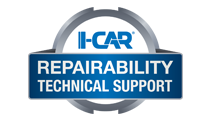
OEM Restraints System Part Replacement Search
2025 Toyota Crown Signia
DISABLE PROCEDURE AND TIME (Always Check Service Manual)
PRECAUTION FOR DISCONNECTING CABLE FROM NEGATIVE AUXILIARY BATTERY TERMINALDepending on the "ACC customize" setting, the background will remain started even when the ignition switch is turned off. For that reason, check the "ACC customize" setting before performing an inspection. When changing the "ACC customize" setting, refer to the precautions for the audio and visual system. When changing the settings, make sure to return the settings to their previous state after the inspection is complete.
• After the ignition switch is turned off, the radio and display receiver assembly records various types of memory and settings. As a result, after turning the ignition switch off, make sure to wait at least 3 minutes before disconnecting the cable from the negative (-) auxiliary battery terminal.
•When the cable is disconnected from the negative (-) auxiliary battery terminal and the security lock setting has been enabled, multi-display operations will be disabled upon next startup unless the password is entered. Be sure to check the security lock setting before disconnecting the cable from the negative (-) auxiliary battery terminal.
• To prevent the key from being locked in the vehicle, make sure to enter e-latch inspection mode and enable the manual release handle before disconnecting the cable from the negative (-) auxiliary battery terminal.
REV: 10/2024
PARTS THAT MUST BE REPLACED FOLLOWING A DEPLOYMENT
When the SRS parts are deployed (including when only an airbag or pretensioner is deployed) due to a collision, be sure to replace all sensors in the damaged areas (anywhere in need of repair) and airbag ECU assembly (center airbag sensor).Replace all sensors in the damaged areas and airbag ECU assembly:
• Airbag ECU assembly (center airbag sensor) [MODULE,AIRBAG CONTROL]
• Front airbag sensors [AIRBAG SENSOR,FRONT]
• Door side airbag sensors [AIRBAG SENSOR,FRT DOOR]
• Side airbag sensor assemblies [AIRBAG SENSOR,QTR PANEL]
• Rear airbag sensors [AIRBAG SENSOR,QTR PANEL]
[Delpoyed] SRS parts:
• Horn button assembly [AIRBAG,STEERING WHEEL]
• Lower No. 1 instrument panel airbag assembly [AIRBAG,KNEE BOLSTER]
• Lower No. 2 instrument panel airbag assembly [AIRBAG,KNEE BOLSTER]
• Instrument panel passenger airbag assembly [AIRBAG,INSTRUMENT PNL]
• Curtain shield airbag assemblies [AIRBAG,ROOF]
• Front seat airbag assemblies [AIRBAG,FRONT SEAT]
• If a front seat airbag assembly has been deployed, replace the front seat airbag assembly, front seatback frame sub-assembly and front seatback pad with cover with the necessary parts in accordance with the extent of the collision damage
PARTS THAT MUST BE INSPECTED AND REPLACED IF DAMAGED
When troubleshooting the SRS, always check for DTCs before disconnecting the cable from the negative (-) battery terminalIn the airbag system, the parts listed below are collectively referred to as the airbag sensors:
• Airbag ECU assembly (center airbag sensor)
• Front airbag sensors
• Door side airbag sensors
• Side airbag sensor assemblies
• Rear seat outer belt assembly
• Pop up hood lifter assembly
• Airbag ECU assembly
• Front airbag sensor
• Pedestrian protection sensor
• Floor side airbag sensor
• Side airbag pressure sensor assembly
• Harness and connector
The parts listed below are collectively referred to as the SRS parts:
• Horn button assembly
• Lower No. 1 instrument panel airbag assembly
• Lower No. 2 instrument panel airbag assembly
• Instrument panel passenger airbag assembly
• Curtain shield airbag assembly
• Front seat airbag assemblies
• Front seat outer belt assemblies
• Rear seat 3 point type outer belt assemblies
Visually check the airbag sensors in undamaged areas for defects:
• If any defects are found or an airbag sensor has detected a major collision, replace the airbag sensor with a new one
• Before using an electric welder on the vehicle, remove any SRS parts around the area being repaired
• Before repairs, remove the airbag sensor assemblies if impacts are likely to be applied to the sensor during repairs
• As the SRS parts are very hot after being deployed, ensure that all wire harnesses and connectors around deployed SRS parts are not damaged
• Inspect SRS parts when the vehicle is damaged in a collision even when the SRS parts are not deployed
Perform zero point calibration and sensitivity check if any of the following conditions occur:
• The occupant detection ECU is replaced
• The front passenger seat is removed from the vehicle
• One of the bolts that is used to install the front passenger seat is removed and reinstalled
• The vehicle is brought to the workshop for repair due to an accident or a collision
Replace any faulty parts of the seat belt systems (outer belt, inner belt, bolts, nuts, tether anchor hardware and other related parts). When inspecting a vehicle that has been involved in a collision, be sure to check all of the seat belt systems regardless of whether or not the system was activated in the collision. Replace any damaged or malfunctioning systems
| Additional Information |
